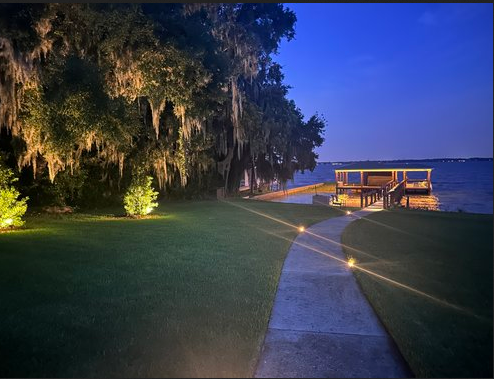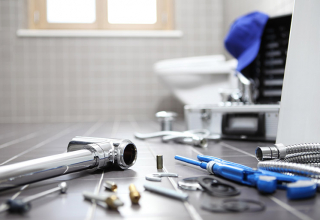
When you start considering the cost of landscape design and installation, it’s easy to get overwhelmed by all the variables involved.
From the type of materials used to the scale of the project and even the time of year you decide to start, several factors come into play. So, let’s break down the key elements that will influence the cost of your landscaping project.
Table of Contents
1. Size Of Your Yard
The most obvious factor that will affect the landscaping cost is your yard’s size. Naturally, the larger your yard, the more materials, labor, and time are needed to transform it into a beautiful space.
A small front yard may require less work than a sprawling backyard with multiple areas to focus on, such as patios, gardens, and walkways.
The cost often scales with the size of the space—larger yards require more plants, more grass seed or sod, and longer hours for installation.
2. Design Complexity
Another huge factor influencing the cost of landscape design and installation services is the complexity of the design you propose.
Do you want a simple garden with a few shrubs, or are you envisioning a multi-level design with intricate hardscaping, water features, and unique plant varieties?
The more detailed your design, the more expensive the project will be. For example, adding a pond, fountain, or intricate stonework requires skilled labor and specialized materials, which can quickly add up.
3. Materials And Plants
The materials you choose for your landscaping can make a big difference in cost. For example, natural stone pathways, brick patios, and premium wood for decks or fences tend to cost more than concrete or composite materials. Similarly, the type of plants you choose impacts the overall price.
High-end, exotic plants or mature trees can significantly raise costs compared to more common, locally available plants or smaller specimens.
Also, consider whether you want annuals that need to be replaced each year or perennials that come back season after season.
If you’re going for a lot of greenery, the cost of plants can quickly add up, especially if you’re purchasing them from specialized nurseries.
4. Labor Costs
Landscaping is a skilled profession, and labor is one of the largest parts of your overall budget.
Depending on the complexity of your design and the tasks required (such as planting, laying sod, installing lighting, or hardscaping), the number of hours required can vary greatly.
Labor rates depend on your location and the company you hire, but landscaping professionals charge an hourly or flat fee for the entire project.
Hire a professional tree service company to come out for a few hours for tree trimming in Islip. However, larger projects will likely require a crew, which increases costs.
It’s a good idea to get several quotes from different landscapers to compare rates and ensure you’re getting fair pricing for the amount of work involved.
5. Hardscaping Features
Hardscaping includes anything in your landscape design that isn’t a plant—think patios, decks, retaining walls, pathways, fire pits, or fences. Hardscaping features can be a major chunk of your landscaping budget.
Installing a well-designed patio, for example, requires materials, excavation, and leveling, which can add significant labor costs.
If you’re looking to create an outdoor kitchen or install a fire pit, you’ll need higher-end materials and more complex installation processes.
Retaining walls are another example of hardscaping that can quickly add to the cost. If your yard is on a slope or requires structural support, a retaining wall can be necessary, but it’s expensive.
6. Irrigation And Drainage Systems
One often overlooked aspect of modern landscape design that can affect your budget is irrigation and drainage systems.
A good irrigation system is essential for maintaining healthy plants, especially if you live in an area with hot summers or irregular rainfall.
If your landscape is on a slope or has flood areas, you’ll need a professional to design and install an effective drainage system.
These systems typically involve pipes, pumps, and grading, all with their costs.
7. Ongoing Maintenance
Landscaping is an investment that doesn’t end after installation. Maintenance costs can add up over time and should be considered when setting your budget.
For example, your lawn needs regular mowing, fertilization, and aeration, while garden beds require weeding and seasonal pruning.
If you choose plants that need special care or regular replacements, this will increase your long-term costs.
Many landscaping companies offer ongoing maintenance packages that can help keep your yard looking its best, but this is an added cost.
8. Seasonal Timing
Believe it or not, the time of year you choose to start your landscaping project can influence the cost.
Landscaping is often in high demand during the spring and summer so that prices may be higher due to the increased demand for labor and materials.
If you’re working with a booked solid landscaper, they may raise their rates or offer less flexibility on timing.
Conclusion
Landscaping is one of the most rewarding ways to enhance the beauty and functionality of your home, but understanding what affects the cost is key to staying within your budget.
Several factors can impact your bottom line, from the size of your yard to the complexity of the design and the materials used.
Knowing what to expect allows you to plan and make informed decisions that will result in a beautiful outdoor space that is both functional and keeps deck costs in Long Island affordable.
With Ecotek Outdoor Lighting, we specialize in creating stunning, functional outdoor spaces that enhance your home’s curb appeal while staying within your budget.
Whether you’re looking to design a tranquil garden, install efficient irrigation systems, or integrate beautiful lighting features, our team is here to help.











